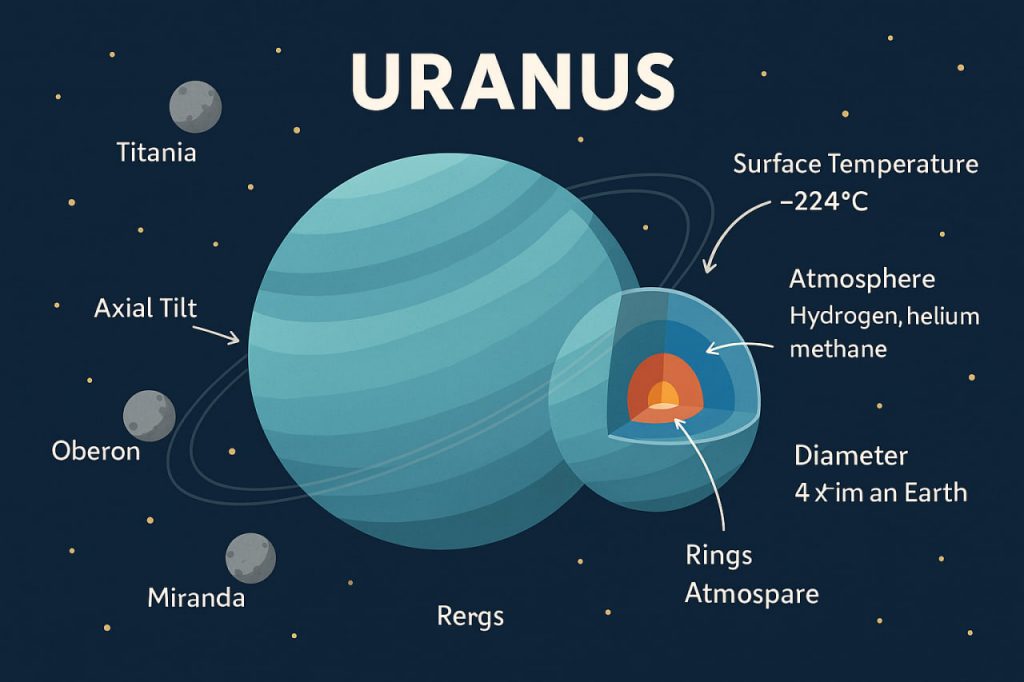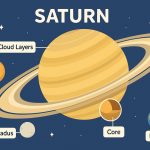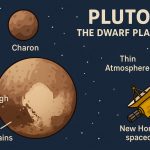Uranus is the seventh planet from the Sun and one of the most mysterious and unusual planets in our Solar System. It is classified as an ice giant, along with Neptune, and is known for its pale blue color, extreme axial tilt, and cold temperatures. Unlike other planets, Uranus spins on its side, making its seasons incredibly long and bizarre.
Key Characteristics of Uranus
- Distance from the Sun: ~2.87 billion km (19.2 AU)
- Diameter: ~50,724 km (about 4 times wider than Earth)
- Day length: ~17 hours
- Year length: ~84 Earth years
- Average temperature: ~-224°C (-371°F) – coldest atmosphere of all planets
- Atmosphere: Hydrogen, helium, and methane
- Moons: At least 27 known
- Rings: 13 faint, dark rings
- Axial tilt: 98 degrees – the planet essentially rolls around the Sun
Why Is Uranus Blue?
The planet’s distinct light blue color is due to methane gas in its atmosphere, which absorbs red light and reflects blue. Its hue is more subdued than Neptune’s because Uranus may contain less atmospheric activity or deeper haze layers that dull the color.
A Planet on Its Side
Uranus’s extreme axial tilt—almost perpendicular to the plane of the Solar System—may have been caused by a massive collision with an Earth-sized object early in its history. As a result, its poles experience 42 years of continuous sunlight, followed by 42 years of darkness.
This tilt also affects the planet’s magnetic field, which is oddly offset from its center and tilted compared to its rotational axis.
Composition and Structure
Uranus is composed of:
- Outer atmosphere: Hydrogen, helium, and methane
- Mantle: Ices of water, ammonia, and methane
- Core: Rocky and possibly Earth-sized
Despite being a gas/ice giant, it has a relatively small core and a dense icy mantle that gives rise to the term “ice giant.”
Moons and Rings
Uranus’s moons are named after characters from Shakespeare and Alexander Pope, such as Titania, Oberon, Ariel, and Miranda. Many of them show evidence of ancient geological activity.
The planet also has 13 dark rings, likely made of rock and dust. They are much fainter than Saturn’s but equally intriguing due to their irregular shapes and mysterious origins.
Exploration of Uranus
So far, only Voyager 2 has visited Uranus, flying by in 1986. It captured the first close-up images and data but didn’t have time for detailed exploration.
Today, many scientists call for a dedicated mission to Uranus, as studying its atmosphere, magnetosphere, and moons could unlock secrets about ice giants and planet formation.
Why Uranus Matters
Understanding Uranus helps scientists:
- Study climate and magnetic field dynamics in tilted planets
- Investigate the formation of giant planets and their moons
- Compare ice giants with the many similar-sized exoplanets found beyond our Solar System
Conclusion
Uranus is one of the least explored planets in our cosmic backyard, yet it may hold crucial clues to the evolution of planetary systems. With its sideways spin, icy composition, and faint rings, Uranus is truly a world unlike any other—and one we hope to understand better in the future.
Glossary
- Ice Giant: A type of gas planet rich in water, ammonia, and methane ices
- Axial Tilt: The angle at which a planet’s axis is tilted relative to its orbit
- Methane: A gas that causes the planet’s blue color
- Magnetosphere: The magnetic field region around a planet
- Voyager 2: NASA spacecraft that visited Uranus in 1986


